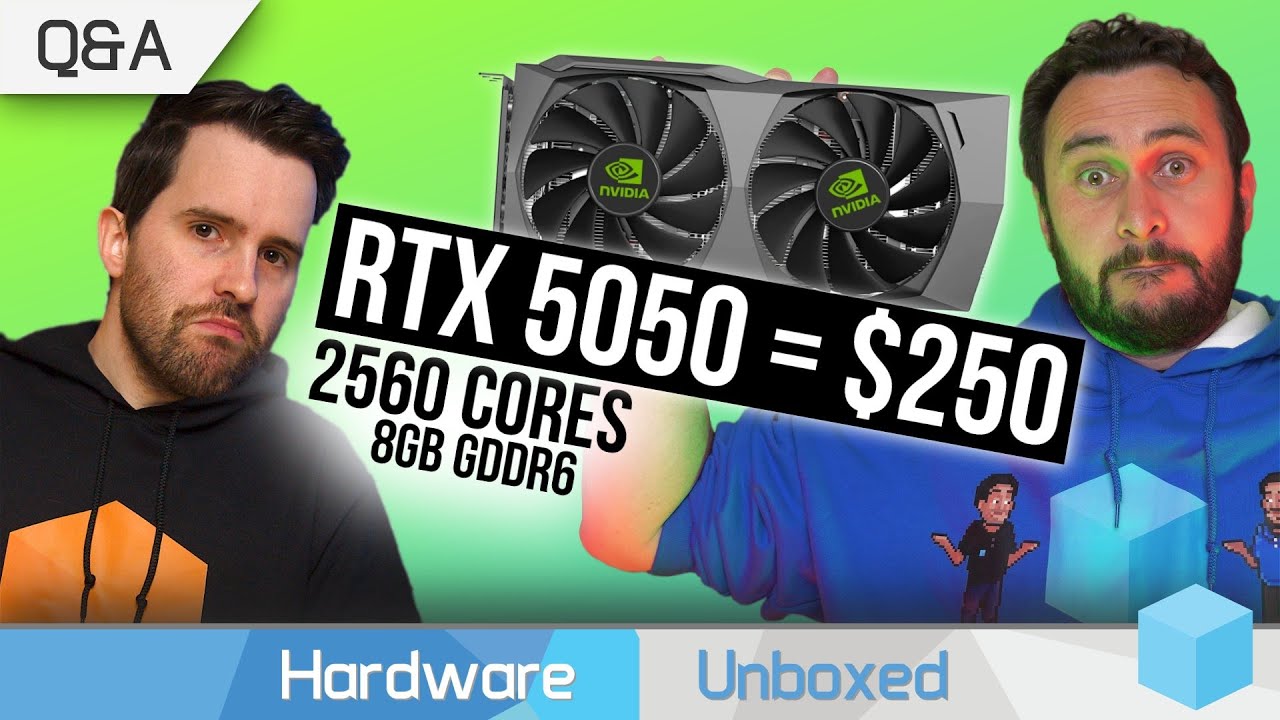In the Harbor Unboxed video, hosts Steve and Tim critique the Nvidia RTX 5050 as a budget GPU with underwhelming performance that may be slower than the RTX 4060 and comparable to older, less impressive cards, cautioning buyers to consider used GPUs for better value. They also discuss broader tech topics including the longevity of AMD’s AM5 platform, the limited benefits of premium GPU models, and Nvidia’s potential ARM-based CPU targeting specialized workloads rather than mainstream gaming.
The video from Harbor Unboxed features hosts Steve and Tim discussing the newly revealed Nvidia RTX 5050 graphics card, which launched quietly on Nvidia’s website without much fanfare. The RTX 5050 is positioned as a budget GPU with 2560 CUDA cores, 8 GB of GDDR6 memory on a 128-bit bus, a boost clock of 2.57 GHz, and a 130-watt TDP, priced at $249 and expected to release in the second half of July. However, the hosts express strong skepticism about the card’s value, criticizing the persistence of 8 GB VRAM in 2025 and noting that the card’s performance is likely to be slower than the RTX 4060, roughly comparable to an older RTX 3060 or AMD RX 7600, which themselves were not highly regarded.
Steve and Tim analyze the RTX 5050’s specifications relative to the RTX 4060 and conclude that the 5050 has fewer CUDA cores and older memory technology, which suggests it will perform worse despite being priced only slightly lower. They also discuss how the card is likely to be popular in pre-built PCs and among gamers looking for a new budget GPU, but caution that used GPUs like the RTX 3060 or 4060 might offer better value. The hosts lament the stagnation in the low-end GPU market, where $250 is now considered entry-level and performance improvements have been minimal compared to previous generations.
The conversation shifts to other tech topics, including the upcoming AM6 socket from AMD, where the hosts advise that consumers should not rush to wait for the next-generation platform since Zen 6 CPUs are expected to arrive in late 2026 and AM5 will remain relevant for some time. They also discuss the trend toward higher core counts in gaming CPUs, clarifying that games do not strictly require a certain number of cores but rather sufficient overall performance. They predict that 10-core CPUs might become the recommended standard in the future but emphasize that core count alone is not the key factor for gaming performance.
Steve and Tim also touch on the performance differences between premium and base models of GPUs like the Radeon RX 7900 XT, explaining that premium variants offer only minor FPS gains (around 3-5%) due to factory overclocking, with the main benefits being better cooling, quieter operation, and aesthetics. They caution against paying large premiums for these models when the performance uplift is minimal and suggest that budget-conscious buyers focus on value rather than flashy features.
Finally, the hosts discuss the rumors of an Nvidia CPU based on ARM cores, speculating that Nvidia’s entry into the CPU market is likely targeted at specialized workloads or AI applications rather than mainstream gaming. They note the challenges of ARM CPUs for gaming on Windows and suggest that Nvidia’s CPU may be more relevant for workstations or integrated systems. The video ends with a discussion about AMD’s future CPU lineup, speculating that six-core models may be phased out in favor of higher core counts as AMD moves to Zen 6, and advising consumers to base purchasing decisions on current platforms rather than waiting for future releases.
